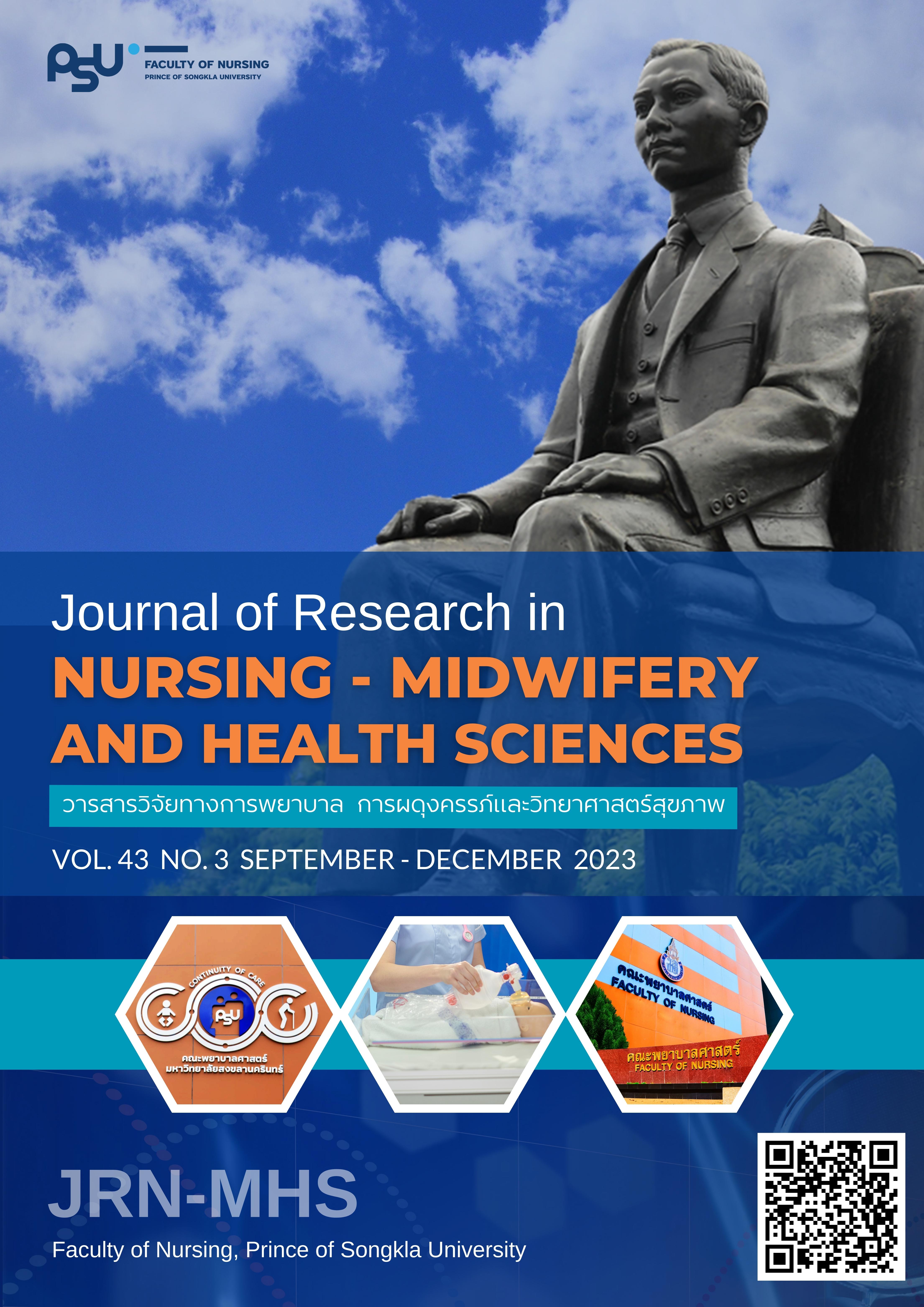ผลลัพธ์การเรียนรู้และความพึงพอใจของนิสิตพยาบาล โดยใช้รูปแบบการเรียนการสอนในยุคปกติวิถีใหม่ของรายวิชาปฏิบัติการพยาบาลมารดาและทารกและการผดุงครรภ์
Main Article Content
บทคัดย่อ
วัตถุประสงค์: เพื่อศึกษาผลลัพธ์การเรียนรู้และความพึงพอใจของนิสิตพยาบาลโดยใช้รูปแบบการจัดการเรียนการสอนในยุคปกติวิถีใหม่ของรายวิชาปฏิบัติการพยาบาลมารดาและทารกและการผดุงครรภ์ วิธีการ: การศึกษาวิจัยครั้งนี้เป็นการวิจัยเชิงสำรวจ กลุ่มตัวอย่างคือนิสิตชั้นปีที่ 3 คณะพยาบาลศาสตร์ มหาวิทยาลัยมหาสารคาม จำนวน 98 คน เครื่องมือที่ใช้ ได้แก่ แบบสอบถามข้อมูลทั่วไป แบบสอบถามความพึงพอใจ และแบบประเมินตนเองตามผลลัพธ์การเรียนรู้ มีค่าความเที่ยงเท่ากับ .96 และ .99 ตามลำดับ วิเคราะห์ข้อมูลโดยใช้ค่าเฉลี่ย ส่วนเบี่ยงเบนมาตรฐาน และสถิติถดถอยพหุคูณ ผลการศึกษา: ผลลัพธ์การเรียนรู้โดยรวมอยู่ในระดับมาก (M = 4.06, SD = .62) และด้านทักษะการปฏิบัติทางวิชาชีพอยู่ในระดับมาก (M = 3.98, SD = .57) ส่วนความพึงพอใจโดยรวมอยู่ในระดับมากทุกด้าน (M = 3.84, SD = .70) พบว่า ความพึงพอใจด้านการเรียนการสอนที่ส่งเสริมการคิดวิเคราะห์สามารถทำนายผลลัพธ์การเรียนรู้ได้ร้อยละ 44 (R2 = .44, p <.001). สรุป: รูปแบบการจัดการเรียนการสอนในยุคปกติวิถีใหม่ของรายวิชาปฏิบัติการพยาบาลมารดาและทารกและการผดุงครรภ์ ควรพัฒนารูปแบบการเรียนการสอนโดยเฉพาะวิธีการสอนที่ส่งเสริมการคิดวิเคราะห์ของนิสิต เพื่อให้เกิดประสิทธิภาพของการสอน และส่งเสริมให้เกิดผลลัพธ์การเรียนรู้ของนิสิตให้เพิ่มมากขึ้น โดยการสนับสนุนอุปกรณ์เครื่องมือสื่อสารโดยเฉพาะสัญญาณเครือข่ายอินเทอร์เน็ตในการจัด
การเรียนการสอนออนไลน์
Article Details

อนุญาตภายใต้เงื่อนไข Creative Commons Attribution-NonCommercial-NoDerivatives 4.0 International License.
เอกสารอ้างอิง
UNESCO. COVID-19 educational disruption and response [Internet]. Paris: UNESCO 2022; [cited 2022 April 21]. Avilable from: https://www.unesco.org/en/articles/covid-19-educational-disruption-and-response
Sasow P, Yuennan C, Peansungnern N. Learning and teaching online in nursing education during the COVID-19 pandemic. J. H. Nsg. Edu. 2020; 26(2): 189-202. Thai.
Department of Disease Control [Internet]. Interactive Dashboard COVID-19. Nonthaburi: Department of Disease Control, Ministry of Public Health; 2022 [cited 2022 Dec 13]. Avilable from: https://ddc.moph.go.th/covid19-daily-dashboard/
Somboontanakorn P, Chaowaneeranat W, Kanyacome S. Behavior of using social media online to support the instruction: The case study of second year students at the level of certificate of vocational education studying the course in using graphics program, Department of Business Computer, Sawang Daen Din Industrial and Community Education. Nakhon Phanom University Journal. 2016; 6(1): 115-23. Thai.
Ministry of Education. Thai Qualifications Framework for Higher Education, TQF: HEd [internet]. Bangkok: Ministry of Education; 2009 [cited 2020 Apr 21]. Available from: https://www.spu.ac.th/uploads/contents/2020053193901.pdf.
Ministry of Education. Thai Qualifications Framework for Higher Education in Nursing Science B.E 2017 [internet]. Bangkok: Ministry of Education; 2018 [cited 2023 Apr 2]. Available from: https://www.tnmc.or.th/images/userfiles/files/Edit(1).PDF.
Mathuros S. Management education online in the new normal COVID-19. RJPJ. 2021; 15(40): 33-42. Thai.
Lertsakornsiri M, Puengsema R. Learning behaviors of nursing students to study online during the COVID-19 situation. JONAE. 2021; 14(1): 23-47. Thai.
Thaewpia S, Potchana R, Intaraphet S. The impact of blended learning on learning achievement, satisfaction, and self-directed learning among nursing students. Journal of Nursing Science & Health. 2019; 42(4): 121-31. Thai.
Thummakul D, Pongkiachai R. Development of learning outcomes of nursing students by using the flipped classroom in research and innovation subject. pnujr. 2022; 14(2): 193-214. Thai.
Intaranongpai S, Kausit U, Tankasem L, et al. Factors influencing the online learning outcome on fundamental nursing subject during COVID-19 pandemic of nursing students from Mahasarakham University. pnujr. 2022; 14(3): 252-66. Thai.
Khamchan P, Thailek T, Thasaneesuwan S. Learning outcome according to Thai Qualifications Framework for Higher Education as perceived by nursing students regarding the hybrid learning approach in an Elementary Nursing Research subject. Songklanagarind J Nurs. 2022; 42(3): 63-7. Thai.
Thongtanunam Y, Sukrapat W, Wankrathok S, et al. Effects of a problem based learning online program for nursing students during COVID-19 global pandemic on learning outcomes according to Thai Qualifications Framework for Higher Education. NJPH. 2021; 31(2): 10-25. Thai.
Phonpakdee R. Using social media in teaching and learning in COVID-19 situation. JIE. 2020; 1(1): 1-5. Thai.
Chonsawat C, Tongvichean S, Meenual K. Entrustable professional activities of fourth-year nursing students in a private university. TJN. 2021; 70(4): 11-29. Thai.
Al-Kahtani N. A survey assessing the health science students’ perception towards online learning at a Saudi Higher Education Institution during COVID-19 pandemic. Heliyon. 2022; 8(9): 1-9. doi: 10.1016/j.heliyon.2022.e10632.
Oducado RMF, Estoque H. Online learning in nursing education during the COVID-19 pandemic: Stress, satisfaction, and academic performance. J Nurs Educ Pract. 2021; 4(2): 143-53. doi: 10.30994/jnp.v4i2.128.
Hao X, Peng X, Ding X, et al. Application of digital education in undergraduate nursing and medical interns during the COVID-19 pandemic: A systematic review. Nurse Educ Today, 2022; 108: 105183. doi: 10.1016/j.nedt.2021.105183.
Bangthamai P, Srisomphan K, Somnukprasert W, et al. Effects of blended learning and childbirth delivery simulation based learning on academic achievement, satisfaction and the students’ opinions towards teaching by reflective thinking of nursing students, Boromarajonani College of Nursing Nonthaburi. JRTAN. 2020; 21(3): 350-9. Thai.
Sáiz-Manzanares MC, Escolar-Llamazares MC, Arnaiz González Á. Effectiveness of blended learning in nursing education. IJERPH. 2020; 17(5): 1589. doi: 10.3390/ijerph17051589.
Jin M, Ji C. The correlation of metacognitive ability, self-directed learning ability and critical thinking in nursing students: A cross-sectional study. Nurs Open. 2021; 8(2): 936-45. doi: 10.1002/nop2.702.
Pham TTT, Le AH, Do DT. The factors affecting students’ online learning outcomes during the COVID-19 pandemic: A Bayesian exploratory factor analysis. Educ Res Int. 2022; 1-13. doi: 10.1155/2021/2669098.
Nakhoda K, Ahmady S, Fesharaki MG, et al. COVID-19 pandemic and e-learning satisfaction in medical and non-medical student: A systematic review and meta-analysis. Iran J Public Health. 2021; 50(12): 2509-16. doi: 10.18502/ijph.v50i12.7933.
Xie H, Wang L, Pang Z, et al. Application of problem-based learning combined with a virtual simulation training platform in clinical biochemistry teaching during the COVID-19 pandemic. Front. Med. 2022; 9: 985128. doi: 10.3389/fmed.2022.985128.
Fakcharoenphol W, Chaowatthanakun K, Varasunun P, et al. Readiness to implement online learning management under the Covid-19 pandemics. JEHDS. 2020; 4(1): 44-61. Thai.


